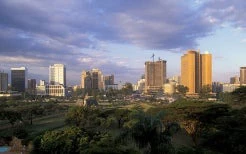In 1884, the General Act of Berlin Conference established borders of African colonies. Many of these “exogenous” borders brought about by Scramble of Africa could be still found on modern maps, now separating sovereign states. About one third of all countries of Sub-Saharan Africa – much larger portion compared to other parts of the world – are landlocked.
Since trade with other countries is important for economic development, and since transportation by sea is much cheaper than any other type of transportation, the evolutionary process of “endogenous” formation of the nation states in other regions left few countries without access to sea. It was not impossible, but certainly more difficult, to develop as a nation without such.
The borders affect the location of Africa’s cities, many of which were founded in the late 19th – early 20th century. More landlocked countries generally mean more cities located inland. And even in the coastal countries, location of major cities was not infrequently dictated by the economic logic of colonialism. Nairobi is an example. A supply depot of the Uganda Railway built to export agricultural commodities from fertile inlands of East Africa was constructed in 1899 in the temperate highlands free of malaria, about 500 km away from the coast. Soon it became the railway's headquarters, a large colonial settlement, and a home to the region’s largest industrial cluster serving East African markets.
The world has changed since. There are no more colonies in Africa, and the logic of today’s global economy dictates that in order to achieve and sustain high rates of economic growth the low-income countries need to export manufactured goods (or services) to large markets. But the legacy of the past does affect the present: cities do not move even if the world changes, and in a highly competitive environment of the global economy, few firms wishing to serve global markets would choose to increase their transportation costs margins by locating inland (unless in the midst of a very large market such as EU, US, or Japan). There might be some exceptions to this, such as firms producing goods which are far more expensive than heavy (such as diamonds), and/or highly perishable (such as cut flowers). But such exceptions are not many. And for the landlocked countries (some of which have high and rapidly growing population densities) distance from the coast is not the only problem. One can think of the landlocked countries' "exogenous" borders as an indication of "extractive institutions" which, once established by colonizers, often persist and affect the countries' economic development for a very long time. My colleague Aaditya Mattoo recently reported that landlocked countries tended to restrict trade in key connective services like transport and telecommunications more than other countries, and that such restrictions had deep instructional roots.
What is the solution to this problem? Cities cannot move, but people can - although it is more difficult to move across borders. Regional economic integration which helps labor mobility would contribute to solving the problem. But to be successful, the process of regional integration needs to be carefully designed.
In a recent report on “Reshaping Economic Geography of East Africa: from Regional to Global Integration” we looked at one of the most dynamic regional integration projects in Africa. Five East African countries—Burundi, Kenya, Rwanda, Tanzania, and Uganda—have made solid progress on integrating in the East African Community (EAC) since 1999, including creation of the customs union and launching implementation of the common market. Still, many problems remain.
For one, the fact that Nairobi—the largest urban and industrial agglomeration—is located inland while the larger coastal cities of Dar es Salaam and Mombasa have few industrial activities (and inefficient ports), creates a risk that agglomeration effects (firms and people locating where other firms and people are) will lead to economic activity still excessively concentrated inland as economic divisions between the EAC countries are removed, and hence to lower productivity than such activity might have on the coast. This would also mean that the region's urbanization will proceed at a slower pace and will continue to be driven relatively more by "push" resulting from rapidly growing population densities in rural areas, and relatively less by "pull" coming from a larger number of jobs created in major urban areas.
For two, many economic divisions between the EAC partner states remain in place even after the agreement to remove them is reached. The customs union has on paper removed obstacles to moving goods within the EAC, but various nontariff barriers remain, such as discrimination against exports and imports of the landlocked Burundi, Rwanda, and Uganda in the ports, and police roadblocks. Equally, the coastal Kenya and Tanzania are responsible for investments in the roads, railways, and ports used by firms from landlocked countries. This asymmetry partly explains why, despite recent improvements, there is underinvestment and poor physical quality of connective cross-border infrastructure.
One reason that partner states do not always honor their obligations is that there are simply no people or entities which have both incentives and capacity to implement integration policies. This is different from the two major success stories of regional integration – Europe and East Asia.
In the European Union, vibrant democracies and a strong rule of law on one side and economic integration on the other created the conditions for such institutions. Governments who have to follow the will of their voters and the rules of an integrated economic system—the two not always coinciding—have incentives to delegate authority to a central body. This promotes further economic integration. To take an example, once the European Commission was established, it filed cases on anticompetitive national practices with the European Court of Justice, which ruled against those practices. Hence the process of integration became politically self-sustaining, driven by regional public institutions. Private firms also benefited tremendously: because Europe is a major part of the global economy, regional integration meant improved access to very large markets for private firms. And the process continues: now we are witnessing a move toward banking and fiscal unions necessitated by existence of and current problems with the monetary union.
East Asia, another example of a successful regional integration, has only one landlocked country (which accounts for very little share of regional output). This creates incentives for private firms to locate parts of their value chains in different partner states to benefit from the economies of specialization.
Regional private associations have strong connections with national governments and advocate integration policies. The process is also catalyzed by multinational corporations.
Limited institutional capacity of the East African countries makes it hard to follow the European model, and national officials have too few incentives to delegate responsibilities to the EAC even when it is in the common interests of all states. And the asymmetry of coastal and landlocked partner states dims the allure of the East Asian model.
The institutional legacy of colonialism in Africa is not easy to overcome. Doing so requires original, context-specific solutions. Our report has put some ideas on the table. They include development of a coastal economic integration zone jointly overseen by five partner states (an idea similar in spirit to Paul Romer’s concept of charter cities which is currently being tried in Ecuador), regionalization of connective infrastructure, improving provision of social services in the landlocked partner states to make their workers more employable, and reducing some asymmetries in the impact of regional integration by means of regional development policy lending until fiscal union becomes a realistic possibility. We hope that these ideas will contribute to the integration policy debates in the region, and will help to shape solutions to the problems it faces.



Join the Conversation